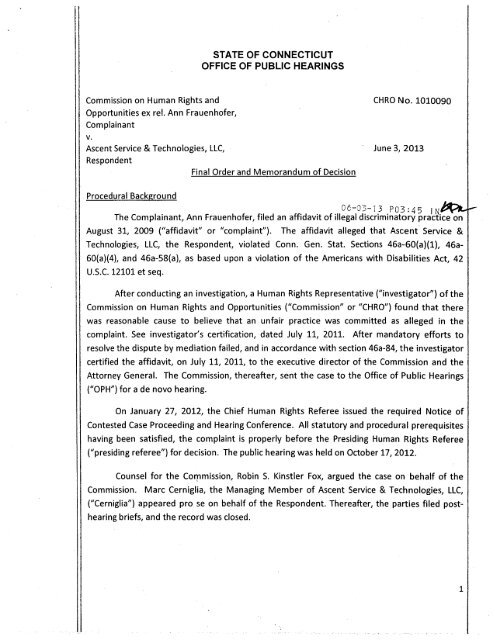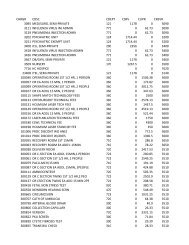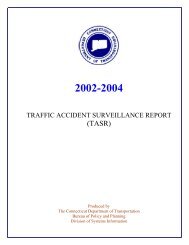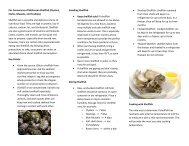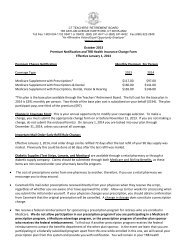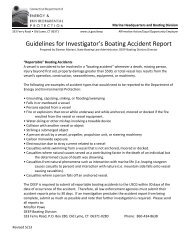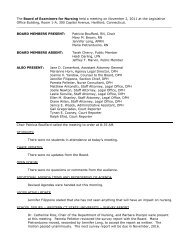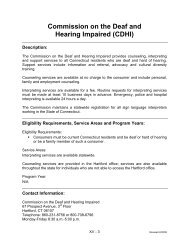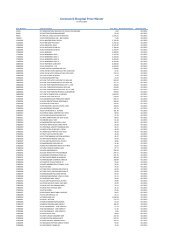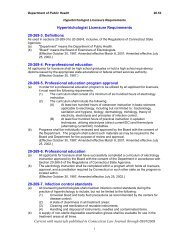STATE OF CONNECTICUT OFFICE OF PUBLIC HEARINGS - CT.gov
STATE OF CONNECTICUT OFFICE OF PUBLIC HEARINGS - CT.gov
STATE OF CONNECTICUT OFFICE OF PUBLIC HEARINGS - CT.gov
You also want an ePaper? Increase the reach of your titles
YUMPU automatically turns print PDFs into web optimized ePapers that Google loves.
<strong>STATE</strong> <strong>OF</strong> <strong>CONNE<strong>CT</strong>ICUT</strong><br />
<strong>OF</strong>FICE <strong>OF</strong> <strong>PUBLIC</strong> <strong>HEARINGS</strong><br />
Commission on Human Rights and CHRO No. 1010090<br />
Opportunities ex rel. Ann Frauenhofer,<br />
Complainant<br />
v.<br />
Ascent Service & Technologies, LLC, June 3, 2013<br />
Respondent<br />
Final Order and Memorandum of Decision<br />
Procedural Background<br />
06-03-13 PG3:45 |<br />
The Complainant, Ann Frauenhofer, filed an affidavit of illegal discriminatory practice on<br />
August 31, 2009 ("affidavit" or "complaint").<br />
The affidavit alleged that Ascent Service &<br />
Technologies, LLC, the Respondent, violated Conn. Gen. Stat. Sections 46a-60(a)(l), 46a-<br />
60(a)(4), and 46a-58(a), as based upon a violation of the Americans with Disabilities Act, 42<br />
U.S.C. 12101 et seq.<br />
After conducting an investigation, a Human Rights Representative ("investigator") of the<br />
Commission on Human Rights and Opportunities ("Commission" or "CHRO") found that there<br />
was reasonable cause to believe that an unfair practice was committed as alleged in the<br />
complaint. See investigator's certification, dated July 11, 2011.<br />
After mandatory efforts to<br />
resolve the dispute by mediation failed, and in accordance with section 46a-84, the investigator<br />
certified the affidavit, on July 11, 2011, to the executive director of the Commission and the<br />
Attorney General. The Commission, thereafter, sent the case to the Office of Public Hearings<br />
("OPH") for a de novo hearing.<br />
On January 27, 2012, the Chief Human Rights Referee issued the required Notice of<br />
Contested Case Proceeding and Hearing Conference. All statutory and procedural prerequisites<br />
having been satisfied, the complaint is properly before the Presiding Human Rights Referee<br />
("presiding referee") for decision. The public hearing was held on October 17, 2012.<br />
Counsel for the Commission, Robin S. Kinstler Fox, argued the case on behalf of the<br />
Commission. Marc Cerniglia, the Managing Member of Ascent Service & Technologies, LLC,<br />
("Cerniglia") appeared pro se on behalf of the Respondent. Thereafter, the parties filed posthearing<br />
briefs, and the record was closed.
At the hearing, the Commission presented evidence regarding the retaliation claim —<br />
section 46a-60(a)(4). Additionally, the post-hearing brief addressed only this claim. Therefore,<br />
the tribunal concludes that the Complainant abandoned all other claims alleged in her<br />
complaint and those claims are not addressed in this decision.<br />
Findings of Fact<br />
The following facts relevant to this decision are found from the evidence and testimony<br />
adduced at public hearing, the complaint, the answer and an assessment of the credibility of<br />
each witness:<br />
,1. On or about May 2008, Respondent's Managing Member, Marc Cerniglia ("Cerniglia"),<br />
entered into an oral agreement with the Complainant to perform bookkeeping services<br />
and to compensate her on an hourly basis at $30.00 per hour. The initial agreement<br />
was for four hours a week. The complainant was tasked with eliminating a backlog of<br />
accounts payable work, as well as processing current transactions. Hearing Testimony<br />
of the Complainant at pages 8, 9, 10 and 13 (hereinafter referred to as "Comp. Tr. #.").<br />
See also, Hearing Testimony of Cerniglia at pages 142 and 143 (hereinafter referred to<br />
as "Cerniglia Tr. #.").<br />
2. On March 6, 2009, Respondent's Business Manager, Christine Carpenter ("Carpenter")<br />
said to the Complainant that Complainant's medication was making her a "motor<br />
mouth." Comp. Tr. 32, 33, and 38.<br />
3. After this March 6, 2009 comment, no other allegedly discriminatory remarks were<br />
made by Carpenter. Comp. Tr. 35, 36, 99 and 100.<br />
4. On or about March 27, 2009, the Complainant told Cerniglia of Carpenter's March 6,<br />
| 2009 remark regarding the effect that medication the Complainant was taking for an<br />
alleged disability. Comp. Tr. 128; Answer, U 9.<br />
5. Cerniglia considered the Complainant's comments to him regarding Carpenter's "motor<br />
mouth" remark to reflect the Complainant's belief that a discriminatory act had<br />
occurred. Cerniglia Tr. 128 and 129. Answer, H 9.1<br />
1 "The Respondent affirms only that a conversation occurred between [Cerniglia] and the Complainant in<br />
which the Complainant alleged [Carpenter] committed a discriminatory act by making an allegedly<br />
boorish remark. [Cerniglia] informed the Complainant that a single act does not necessarily constitute<br />
discrimination, rather, repetition of similar behavior is necessary. [Cerniglia] said that he would look<br />
into the matter and inform the Complainant of what he learned." Answer, H 9a. "After questioning and<br />
speaking with [Carpenter] about the allegation, [Cerniglia] reported back to the Complainant that while<br />
he had found nothing to indicate that a discriminatory act had occurred, he did instruct [Carpenter] to<br />
be more mindful of her word choice around the Complainant." Answer, H 9b.
6. Cerniglia spoke with Carpenter about the alleged remarks and admonished her not to<br />
say such things around the Complainant because the Complainant "had sensitivity about<br />
some comments." Cerniglia told Carpenter to "cease and desist" from making such<br />
remarks to the Complainant. Cerniglia Tr. 130 and 131.<br />
7. After speaking with Carpenter, Cerniglia reported back to the Complainant his belief<br />
that no discriminatory act had occurred and that he admonished Carpenter not to make<br />
any more comments. Cerniglia Tr. 131.<br />
8. On or about April 22, 2009, the Complainant told Carpenter that Complainant's<br />
psychiatrist expressed an opinion (on or about April 15, 2009) that Carpenter's "motor<br />
mouth" comment was illegal. Comp. Tr. 38-40.<br />
9. On April 28, 2009, Carpenter left a voice message on the Complainant's answering<br />
machine instructing her not to come to the office the next day and that Cerniglia would<br />
call the Complainant. Comp. Tr. 42-43.<br />
10. On or about May 1, 2009, Cerniglia telephoned the Complainant and informed her that<br />
her services as a bookkeeper would no longer be needed.2 Comp. Tr. 43.<br />
11. Cerniglia was solely responsible for Respondent's hiring and firing decisions. Cerniglia<br />
Tr. 137.<br />
12. The Respondent lost its license to inspect elevators in New York City early in 2009. The<br />
delay in obtaining its NYC license renewal had a significant impact on Respondent's<br />
revenues in 2009. Cerniglia Tr. 126. Answer page 12 of 13.<br />
13. In addition to the Complainant, the Respondent dismissed four employees from March<br />
2009 to July 2009. Cerniglia Tr. 127 and Answer pages 12 of 13 and 13 of 13.<br />
Employee or Independent Contactor<br />
During the public hearing evidence was introduced intended to establish that the<br />
Complainant was the Respondent's employee. Additionally, in its post-hearing brief, the<br />
Commission argues that the Complainant was the Respondent's employee. The Respondent<br />
disputed this assertion.<br />
In light of the current posture of this case - the only remaining claim is a violation of<br />
Section 46a-60(4) - this question need not be resolved. There is no legal significance to this<br />
2 Although the affidavit of discriminatory practice contained an allegation that Cerniglia told the<br />
Complainant during this call that Carpenter had told him about this April 22, 2009 disclosure "and added<br />
that the one remark did not constitute harassment", no evidence was offered at the hearing to support<br />
this allegation. See affidavit 1115.
determination because, as the Commission correctly argues, under this provision the<br />
complainant need not be an employee.3<br />
Retaliation<br />
According to section 46a-60(a)(4), it is unlawful "[f]or any person [or] employer ... to<br />
discharge, expel or otherwise discriminate against any person because he has opposed any<br />
discriminatory employment practice ...." A retaliation claim under section 46a-60(a)(4) is<br />
analyzed under one of the numerous variants of the burden shifting framework originally set<br />
forth in McDonnell Douglas v. Green. 411 U.S. 792, 802-804 (1973). (See, e.g., Cosgrove v.<br />
Sears, Roebuck & Co.. 9 F.3d 1033, 1038-39 (2d Cir. 1993), CHRP ex rel. Nobili v David E. Purdv<br />
& Company, LLC. et al.. CHRO No. 0120389 (2004) and CHRP ex rel. Shea v. Spruance. et al.r<br />
CHRO No. 9640243 (1999)). First, the complainant must satisfy the burden of proving her prima<br />
facie case.4 Tomka v. Seiler Corp.. 66 F.3d 1295, 1308 (2d Cir. 1995): Newtown v. Shell Oil Co.,<br />
52 F.Supp.2d 366, 373 (1999). This burden is de minimus. CHRO ex rel. Nobili. CHRO No.<br />
0120389 (2004).<br />
Once this burden is met, a rebuttable presumption of retaliation is established, and the<br />
respondent must articulate a legitimate, non-discriminatory reason for taking the adverse<br />
employment action. McDonnell Douglas, 411 U.S. at 802; Tomka, 66 F.3d at 1308; Newtown. 52<br />
F.Supp.2d at 373. If the respondent's proffer is credible, the burden shifts back to the<br />
complainant to prove that the articulated reason was false and a pretext for retaliation. The<br />
3 The affidavit alleged violations of Sections 46a-60(a)(l), 46a-60(a)(4), and 46a-58(a), as based<br />
upon a violation of the Americans with Disabilities Act, 42 U.S.C. 12101 et seq (ADA). To the<br />
extent that section 46a-58(a) has been interpreted to transmute the substantive and retaliation<br />
provisions of federal employment discrimination law, including the ADA, into its provisions, and thereby<br />
afford a complainant the remedies available under section 46a-86(c), it is not an issue here because<br />
mental disability is not one of the categories enumerated under section 46a-58(a).<br />
4 Under the McDonnell Douglas framework, the Complainant's initial burden is not onerous.<br />
"Recognizing that 'the question facing triers of fact in discrimination cases is both sensitive and difficult,'<br />
and that '[t]here will seldom be 'eyewitness' testimony as to the employer's mental process,' ..., the<br />
Courts of Appeals ... have employed some variant of the framework articulated in McDonnell Douglas to<br />
analyze [discrimination] claims that are based primarily on circumstantial evidence." Reeves at 141.<br />
"McDonnell Douglas and subsequent decisions have 'established an allocation of the burden of<br />
production and an order for the presentation of proof in ... discriminatory-treatment cases.' St. Mary's<br />
Honor Center v. Hicks. 509 U.S. 502, 506 (1993)." Reeves at 142.
complainant must prove that respondent's action was "prompted by an impermissible motive."<br />
Tomka, 66 F.3d at 1308; Newtown, 52 F.Supp.2d at 374. The ultimate burden of persuasion<br />
remains at all times with the complainant. Sumner v. US Postal Service, 899 F.2d 203, 209 (2d<br />
dr., 1990) (citing Texas Dept. of Community Affairs v. Burdine. 450 U.S.248, 253 (1981)).<br />
In a retaliation case, liability depends on whether the discharge was motivated<br />
retaliation. Gordon v. New York City Bd. Of Educ.. 232 F.3d 111, 116 (2d Cir. 2000)("[W]hen a<br />
retaliation case goes to the jury, [its] task is simply to determine the ultimate question of<br />
whether the plaintiff met her 'burden of proving that the defendant was motivated by<br />
prohibited [retaliation].'")(citations omitted). The ultimate question is whether the<br />
complainant has proven, by a preponderance of the evidence, that the respondent intentionally<br />
retaliated against her because she engaged in protected activity. Cosgrove, 9 F.3d at 1039.<br />
Sumner, 899 F.2d at 209 (citations omitted).<br />
Complainant's Prima Facie Case<br />
To satisfy her prima facie case burden of proof, the complainant must establish that (1)<br />
she participation in a statutorily protected activity; (2) the respondent was aware that the<br />
complainant participated in such activity; (3) an adverse employment action was taken by the<br />
respondent that disadvantaged the complainant; and (4) a causal connection existed between<br />
the participation in the protected activity and the adverse action. Reed v. A. W. Lawrence &<br />
Co., Inc., 95 F.3d 1170, 1178; Manoharan v. Columbia University College of Physicians &<br />
Surgeons, 842 F.2d 590, 593 (2d Cir. 1988); Avantola v Bd. Of Trustees of Technical Colleges.<br />
116 Conn. App. 531, 536 (2009); Nelson v City of Bridgeport. 2012 WL 4902812 at 13 (Conn.<br />
Super.) and CHRP ex rel. Malizia v. Thames Talent, Ltd.. CHRO No. 9820039 (2000). This burden<br />
is not onerous. Id. (citing Ann Howard's Apricots Restaurant. Inc. v CHRO, 273 Conn. 209, 225<br />
(1991)).<br />
The complainant is not required to establish that the conduct she opposed actually<br />
violated a state law prohibiting employment discrimination to prove that she was engaged in a<br />
protected activity. She need only have a "good faith reasonable belief that the underlying<br />
challenged actions of the employer [or other person] violated the law." Reed, 95 F.3d at 1178<br />
(citing Manoharan 842 F.2d at 593); Malizia v. Thames Talent. Ltd.. CHRO No. 9820039 (2000).<br />
Although the record reveals that the Complainant may or may not have said to the<br />
Cerniglia that she believed Carpenter's alleged "motor mouth" comment to be illegal, Comp. Tr.<br />
103 and 104, she immediately perceived the remark to be highly offensive and later that day,
after taking time to calm herself, told Carpenter the remark was inappropriate.5<br />
Approximately three weeks later, Complainant reported the incident to Cerniglia. Cereniglia Tr.<br />
128.<br />
Specifically, Complainant testified that, on March 27, 2009, she called Cerniglia to<br />
arrange a meeting to discuss how to reduce/eliminate interruptions by Carpenter that<br />
interfered with the Complainant's productivity. Comp. Tr. 34. The Complainant stated that<br />
during the course of her conversation with Cerniglia, after she had addressed the interruptions<br />
issue, she "just mentioned the fact that [Carpenter] made this comment to me and that it was<br />
inappropriate, and that... I was kind of upset about it, but... I wasn't going any further with it."<br />
Complainant then elucidated her testimony saying this meant that she, at that time, "had no<br />
intentions of... creating a lawsuit or complaining to anyone." Comp. Tr. 34-35.<br />
Cerniglia also testified that, "[sjometime in March, [Ms.] Frauenhofer approached me in<br />
the office, stating that Mrs. Carpenter had made an illegal discriminatory action by calling her a<br />
motor mouth because of her PTSD and medications. At that time, I asked her if there were any<br />
other incidents that had occurred. Her answer was no. I also told her that I would look into the<br />
matter and get back to her. I also told her that albeit distasteful, a single comment does not, in<br />
and of itself, constitute a discriminatory act...." Cereniglia Tr. 128.6 The Complainant testified<br />
that she did not recall what Cerniglia said during that conversation. Comp. Tr. 35. No evidence<br />
was presented to discredit Cerniglia's recollection of his conversation with the Complainant on<br />
March 27, 2009, or his subsequent actions.<br />
5 The Complainant testified to being so angry and embarrassed that she had to walk away from Ms.<br />
Carpenter to regain her composure. Comp. Tr. 33.<br />
6 Additionally, Respondent admitted in its Answer H 9 that:<br />
"[A] conversation occurred between [Cerniglia] and the Complainant in which the<br />
Complainant alleged [Carpenter] committed a discriminatory act by making an allegedly<br />
boorish remark. [Cerniglia] informed the Complainant that a single act does not<br />
necessarily constitute discrimination^] rather, repetition of similar behavior is<br />
necessary. [Cerniglia] said that he would look into the matter and inform the<br />
Complainant of what he learned." Answer f 9a. "After questioning and speaking with<br />
[Carpenter] about the allegation, [Cerniglia] reported back to the Complainant that<br />
while he had found nothing to indicate that a discriminatory act had occurred, he did<br />
instruct [Carpenter] to be more mindful of her word choice around the Complainant."<br />
Answer H 9b.
I conclude that the Complainant's disclosure of Carpenter's remark to Cerniglia and his<br />
reaction to the Complainant's remarks establish that she possessed the good faith reasonable<br />
belief that the comments violated the law. Therefore, the Complainant has met the first three<br />
prongs of her burden to establish a prima facie case - (1) she participated in a statutorily<br />
protected activity; (2) the respondent was aware that the complainant participated in such<br />
activity; and (3) an adverse employment action was taken by the respondent that<br />
disadvantaged the complainant.<br />
Causal Connection<br />
A complainant seeking redress for retaliation pursuant to section 46a-60(a)(4)/ may<br />
satisfy the causation element "either (1) directly, through evidence of retaliatory animus ...; or<br />
(2) indirectly, by showing that the protected activity in question was closely followed in time by<br />
the adverse action." Miller v. Ethan Allen Global. Inc.. 2011 WL 3704806 (D. Conn.), p.8. CHRP<br />
ex rel. Nobili. CHRO No. 0120389 (2004). "Without awareness by a decision-maker, it will be<br />
hard to find any causal connection between the protected activity and the adverse action." Id.<br />
(citing Galdeieri-Ambrosini v. Nat'l Realty & Dev. Corp.. 136 F.3d 276, 292 (2d Cir. 1998).<br />
The Commission argues that courts have noted that temporal proximity can give rise to<br />
a reasonable inference of a causal connection between the protected activity and the adverse<br />
employment action. Citing Newtown v. Shell Oil Company, 52 Fed. Supp. 2d. 366 (D. Conn<br />
1999) (employee received bad performance review and was fired after filing complaint with the<br />
CHRO and the EEOC); Reed v. A.W. Lawrence & Co.. Inc.. 95 F.3d 1170, (2d. Cir., 1996)<br />
(employee complaint to employer about sex discrimination followed by termination); and<br />
Tomka v. Seiler Corp., 66 F.3d 1295 (2d Cir., 1995) (plaintiff terminated weeks after informing<br />
her supervisor she may press criminal charges and take other unspecified legal action for<br />
alleged work-related sexual assault). See also CHRO ex rel. Nobili. CHRO No. 0120389 (2004)<br />
("Close temporal proximity between the protected express and the adverse action has often<br />
justified an inference of causality.")<br />
The evidence reveals that on or about April 15, 2009, the Complainant's psychiatrist<br />
allegedly said to the Complainant that Carpenter's remark was "illegal." Comp. Tr. 37 and 39.<br />
Subsequently, on April 22, 2009, the Complainant communicated her psychiatrist's opinion to<br />
Carpenter. No other person, including Cerniglia, participated in that latter conversation. There<br />
is no evidence that the Complainant, or any other person, made Cerniglia aware of the remark
attributed to the Complainant's psychiatrist prior to Cerniglia's call to the Complainant, on or<br />
about May 1, 2009, informing her that her services were no longer needed.7<br />
The Complainant speculated that she felt Ms. Carpenter possibly told Cerniglia about<br />
her psychiatrist's comment and that she felt that Carpenter and Cerniglia "obviously did have a<br />
discussion ...." Comp. Tr. 43. She stated,<br />
I don't know what [Carpenter] said, but I kind of got the impression, seeing I was<br />
terminated so quickly after [my April 22 disclosure to Carpenter], that she went<br />
to him and maybe told him the exact opposite of what I told her, maybe denied<br />
that she made the [motor mouth] comment. Like I said[,] I don't know, but it just<br />
seemed rather strange that she would tell me that he would call me .... I kind of<br />
felt like I was fired.<br />
Comp. Tr. 43-44.<br />
Respondent objected to Complainant's speculation regarding Carpenter having had such<br />
a discussion with Cerniglia. Furthermore, in response to the Presiding Referee's inquiry - "Did<br />
Ms. Carpenter say anything to you about the need to terminate the Complainant?" -- Cerniglia<br />
said no, that he and Carpenter never discussed the need to fire the Complainant. Id. 159-160.8<br />
Although the evidence reveals that Cerniglia spoke with Carpenter after the<br />
Complainant disclosed her psychiatrist's opinion to Carpenter9, there is no evidence that<br />
7 This is striking because although the Complainant testified about the May 1, 2009 termination call<br />
(Comp. Tr. 43-45), she provided no testimony to support the allegations in her complaint that Cerniglia<br />
told her during this call that Carpenter had informed him of the psychiatrist's comment. Complaint H 15.<br />
(Although the Respondent's Answer did not directly deny this allegation, the Complainant's failure to<br />
offer probative evidence on this subject precludes this tribunal from finding for the Complainant on this<br />
point.) Additionally, Complainant's only testimony indicating she told Cerniglia about her psychiatrist's<br />
April 22, 2009 opinion was provided as she described a conversation they supposedly had during their<br />
March 27, 2009 lunch meeting. Comp. Tr. 102-103.<br />
8 Neither party called Carpenter as a witness.<br />
9 On or about April 29, 2009, Cerniglia instructed Carpenter to tell the Complainant not to come in the<br />
next day and that he would call her. Cerniglia Tr. 135 and 154. Cerniglia testified that "for a while I<br />
struggled with it, but ultimately decided on April 30th, I couldn't do it... I told Mrs. Carpenter not to -to<br />
tell the Complainant not to come in for no other reason, and we were too busy to deal with the issue<br />
then." Cerniglia Tr. 135. Subsequently, Carpenter left a message to that effect on<br />
Complainant's answering machine. Comp. Tr. 42-43.
Carpenter made Cerniglia aware of that remark, prior to his call to the Complainant to end their<br />
arrangement.<br />
Therefore, to the extent that there is a casual connection sufficient to establish this<br />
prong, it must be between Complainant's disclosure to Cerniglia on March 21, 2009 and her<br />
discharge, on May 1, 2009. I conclude that the five or so weeks between the March 27<br />
disclosure and the May 1 adverse action is sufficient circumstantial evidence for the<br />
Complainant to satisfy the fourth prong of her prima facie case.<br />
Legitimate Business Reason<br />
The Respondent merely need proffer a legitimate non-retaliatory business reason for its<br />
adverse action. Nelson v City of Bridgeport, 2012 WL 4902812 at 13 (Conn. Super.) (citing<br />
Beizzer v. Department of Labor, 56 Conn. App. 347, 355-56, cert, denied, 252 Conn. 937 (2000)).<br />
Respondent has done so.<br />
Cerniglia presented evidence of a significant drop in Respondent's revenues. He testified<br />
that its NYC elevator inspection license renewal was delayed and resulted in a substantial<br />
revenue loss beginning in January 2009. He testified that once the license was renewed, in<br />
April 2009, Respondent was "unable to establish contracts with ... a brand new customer base,<br />
and, therefore, lost a lot of revenue." Cerniglia Tr. 126. Cerniglia also pointed to page 12 of 13<br />
of the Answer filed in which he noted that Respondent's revenues had fallen off approximately<br />
65%.10 Additionally, Cerniglia testified that due to the downturn in business, Respondent<br />
terminated five employees (in addition to the Complainant) — four within a few months of<br />
Complainant's discharge - May 2009. Cerniglia Tr. 127. Those terminations occurred March<br />
2009 (S. Kamini); April 2009 (A. Freeman); June 2009 (A. Pejman); July 2009 (L Seaburg) and<br />
March 2010 (S. Banks). See Answer page 13 of 13 and Cerniglia Tr. 127.<br />
Respondent has articulated a legitimate, non-retaliatory rationale for the adverse action<br />
taken. Therefore, the burden of proof shifts back to the Complainant to demonstrate by a<br />
preponderance of the evidence that the Respondent's reasons are merely a pretext for<br />
retaliation.<br />
10 Cerniglia also testified about losing a contract with the Metropolitan Museum of Art, in New York City<br />
- resulting in a loss of $10,000 per month. (It is unclear from the record when this loss occurred.)<br />
Cerniglia Tr. 125-126.
Pretext<br />
The Complainant must present evidence that satisfies her ultimate burden of proving<br />
that retaliation "played a motivating role in, or contributed to, the employer's decision."<br />
Gordon v. New York City Bd. Of Ed.. 232 F.3d, at 117 (quoting Renz v. Grey Advertising. Inc.. 135<br />
F.3d 217, 222 (2d Cir. 1997)). Section 46a-60(4) "is violated when a retaliatory motive plays a<br />
part in adverse employment actions ... whether or not it was the sole cause." See Id. at 117<br />
(quoting Cosgroye, 9 F.3d at 1039).<br />
"The critical question is whether a plaintiff has proven by a preponderance of the<br />
evidence that the defendant intentionally discriminated or retaliated against the plaintiff for<br />
engaging in protected activity." Id. (citation omitted). "[Tjhere are two distinct ways for a<br />
plaintiff to prevail - 'either by proving that a discriminatory motive, more likely than not,<br />
motivated the defendants or by proving that the reasons given by the defendants are not true<br />
and that discrimination is the real reason for the actions.'" Id. (quoting Fields, 115 F.3d at 121).<br />
"One basis for inferring discrimination is plaintiff's proof of her prima facie case<br />
combined with the jury's disbelief of defendant's explanation for its actions." Gordon v. New<br />
York City Bd. Of Ed., 232 F.3d, at 116-17 (Citing Cabrera, 24 F.3d at 382). The Second Circuit<br />
"has consistently held that proof of causation can be shown either: (1) indirectly, by showing<br />
that the protected activity was followed closely by discriminatory treatment, or through other<br />
circumstantial evidence such as disparate treatment of fellow employees who engaged in<br />
similar conduct; or (2) directly, through evidence of retaliatory animus directed against the<br />
plaintiff by the defendant." Gordon. 232 F.3d at 117 (citation omitted).<br />
The Complainant argues that the Respondent's proffered reason, a loss of business and<br />
reduction in revenues, are a pretext for retaliation. Complainant's primary evidence of<br />
retaliation was the short time period from her communication with Carpenter, on April 22,<br />
2009, and Cerniglia's call to her, on or about May 1, 2009, terminating her services. As<br />
explained previously, this tribunal determined that this is not the proper benchmark because<br />
there is no evidence that Cerniglia was aware of the Complainant's disclosure.<br />
Additionally, as evidence of pretext, the Complainant argues that the Respondent's<br />
efforts to create new work area for her, about one week before her dismissal, prove that the<br />
Respondent had sufficient resources to retain her. Those efforts were minimal - Cerniglia<br />
personally moving 2 six-foot tall bookcases, a copy machine and a desk and the Respondent<br />
expending some unspecified amount to hire an electrician to repair an outlet. Cerniglia Tr. 133-<br />
10
34. The only evidence offered by the Complainant to discredit Respondent's assertion that it<br />
terminated her and five other employees due to the downturn in business was that Cerniglia<br />
had hired an Administrative Assistant in February 2009 - Laura Seaburg. Comp. Tr. 32. Seaburg<br />
was terminated in July 2009. Cerniglia Tr. 127. Answer page 13 of 13.<br />
Upon a thorough review of the record, the presiding referee concludes that insufficient<br />
evidence was produced to satisfy the Complainant's burden to establish that the reasons<br />
offered by the Respondent constitute a pretext for retaliation or that the Respondent<br />
possessed a retaliatory motive. Therefore, I find no violation of section 46a-60(a)(4).<br />
Final Decision and Order<br />
In light of the foregoing, I find in favor of the Respondent. It is hereby ordered, in<br />
accordance with the provisions of subdivision (4) of subsection (d) of section 46a-54-88a of the<br />
j Regulations of Connecticut State Agencies, that the complaint be, and hereby is, dismissed.<br />
It is so ordered this 3rd day of June 2013.<br />
Alvin R. Wilscfn, Jr.<br />
Presiding Human Rights Referee<br />
/<br />
cc.<br />
Ann Frauenhofer<br />
Marc Edward Cerniglia<br />
Robin Kinstler-Fox, Esq.<br />
11


